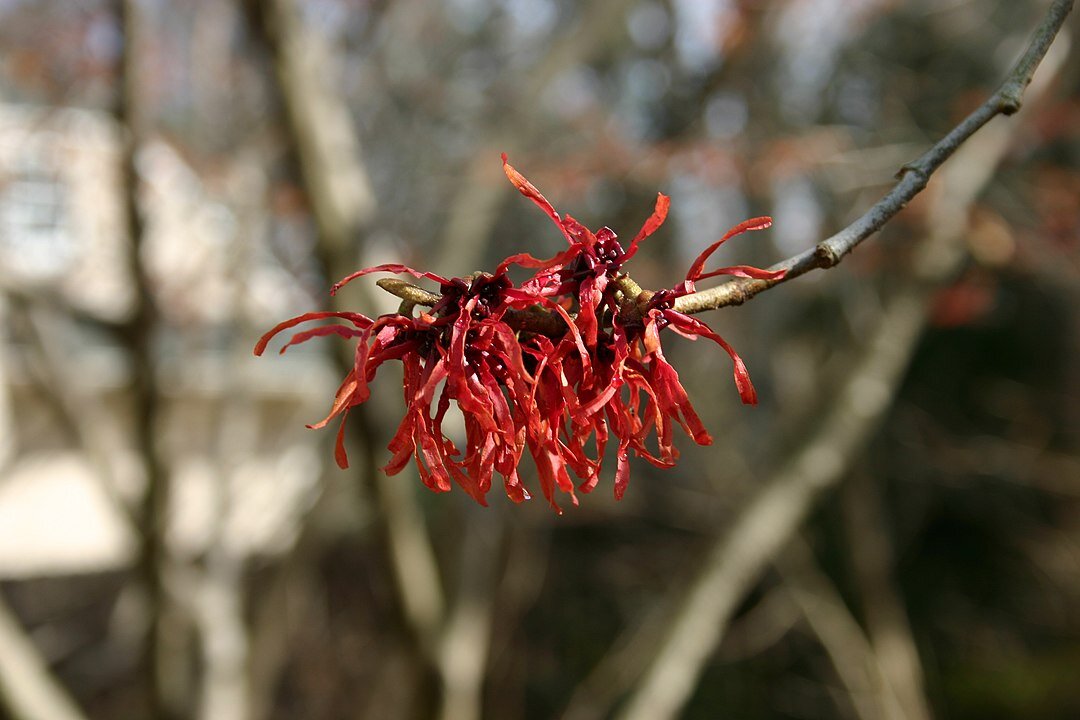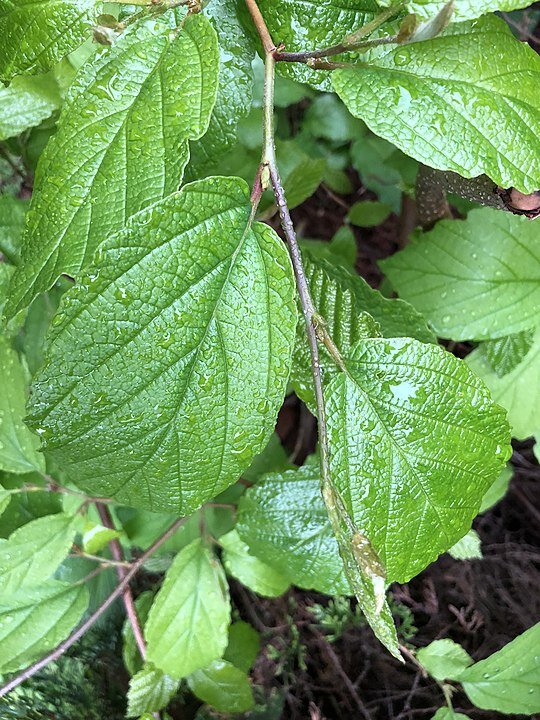Witch hazel is a wonderful medicinal plant that has many soothing properties. It is traditionally used for bruises, bug bites, and skin irritations. Medicine is made from the leaves, bark, and branches. Learn how to grow this wonderful tree and make several healing remedies.
I have to admit the idea for this article came to me because Goober Goose bit me. Hard. It hurt. I was trying to get him to stop attacking Bob the goat. Goober passed in 2021 but he was a beloved member of Fox Run!
So I stomped off to the house to find the bottle of witch hazel. Look in the bathroom, no witch hazel. Look on my bedside table, no witch hazel. This leads me on a quest through the house. You may accurately gather that I tend to place things down and forget where I put them.
Unable to locate the bottle, I decided to just go back to the source. So I tromp back outside to the fenceline where my witch hazel trees grow. I grabbed a twig with a couple of leaves, and trotted back to the house.
Boil, cool, apply to my bruises. AHHHH relief.
This article will share with you all about the witch hazel tree. How to grow them and how to make wonderful medicinal salves and body care products.
What is Witch Hazel?
In addition to all the wonderful medicinal qualities, witch hazel is also a very attractive tree. There are several cultivars of witch hazel but our main native species is Hamamelis virginiana.
It is one of the rare ornamental trees that flowers in fall and winter. The small spider-like flowers bloom in late fall just before the leaves drop from the tree. The foliage turns a pretty yellow or orange before falling to the ground.
The gorgeous flowers are shades of yellow, orange or red depending on the variety. They resemble little fireworks going off in the sky. In fact, the blossoms produce seeds that are literally shot off from the tree, sometimes going twenty-five feet from the mother tree.
How To Grow Witch Hazel
Witch hazel is a deciduous shrub or small tree. They appreciate full sun to partial shade. They live in the fringes of wooded areas and along creek beds.
Witch hazel does well in a mixed shrub border, with other large deciduous shrubs such as lilac and viburnum. Around the base, you can plant companion plants such as hellebores, winter heath, and bulbs of hardy cyclamen and snowdrop.
How To Plant
They grow ten to twenty feet tall and have a ten-foot spread. Plant your trees ten feet apart.
They are slightly acidic and need similar soil as elderberries. Read my article on growing and using elderberry here.
They want soil between 6.0 and 6.5 so you may want to add cottonseed meal when planting. Give them a good shovel scoop of compost when you plant.
Mulch with pine needles or wood chips to keep the soil moist and around pH. Most varieties grow readily in zone 5-8.
Prunning
You can prune your tree to keep it the size you want. Prune in late spring before summer buds (remember it has a different bloom schedule).
Many websites label them as deer resistant. I will say I think my deer have avoided them BUT my goats have ravaged them more than once. Those winter flowers are certainly enticing.
In general they are very hardy and resistant to pests and diseases. However, some of the hybrids are susteptible to leaf blights and mildew.
Witch hazel is easy to grow. Young trees can be purchased locally or online. I bought one of mine from Fedco Trees. The other one I purchased on Amazon.
Varieties
Arnold Promise
Very fragrant and has beautiful fall foliage with yellow flowers that bloom in late winter.
Primavera
has very fragrant yellow flowers in late winter and attractive golden leaves in fall. ‘
Diane
Stunning, with red-copper colored, late winter-blooming flowers. Not as fragrant and smaller at ten feet tall. More heat resistant and will grow down through zone 9.
Common witch hazel (H. virginiana)
This is the native tree which is hardy in USDA zones 4 - 8. Found throughout the Appalachian Mountain range. It gets to be about twenty feet tall and blooms October to December with yellow flowers. Best for using herbal treatments.
Witch Hazel History
Sadly the word witch in witch hazel does not really reference the witch who does magic spells. That makes me sad because I like to envision myself at the caldron stirring up medicinal potions.
Witch actually comes from the old English word wice which means bendable. The stems from the witch hazel tree were used as "divining rods" to look for underground water. It was believed the branch would bend downwards toward the ground when there was water there.
Witch hazel was named by the famous botanist Carl Linnaeus. The botanical name Hamamelis is broken down into the Latin; “hama” meaning “at the same time”, and “melis” for the fruits.
Native Americans used witch hazel to treat many illnesses including skin irritations, sore muscles, and even dysentery.
Witch hazel was the first mass-marketed American-made toiletry in 1846, originally named Golden Treasure. Today it is used in cleansers and astringents by large cosmetic companies like Neutrogena and L’Oreal. It is also one of the few medicinal herbs to receive FDA approval.
Today witch hazel can be purchased in liquid or cream form at most pharmacies.
Check out my YouTube Channel
Medicinal Properties
Historically, witch hazel has been used as a traditional medicine in many cultures. But science has proven that this tradition is justified.
Scientific studies have proven that the compounds found in witch hazel, gallic acid and natural tannins, soothe irritated skin. The tannins can also kill bacteria and reduce erythema, a reddening of the skin. Witch hazel also reduces harmful free radicals and prevents skin from damage. Scientists are studying witch hazel as a method to help prevent skin cancer.
I can personally attest it soothes bruises including those inflicted by a pet goose! Applying the leaves to a cut can slow down minor bleeding.
Safety
Witch hazel is considered to be very safe when applied externally on the skin for all ages.
Small doses internally are considered somewhat safe. It may cause nausea and large doses are harmful to the liver. It is not recommended that you ingest it internally if you are pregnant.
Making Homemade Remedies Out Of Witch Hazel
There are several Witch hazel remedies and skin care products that are easy to make.
Check out the recipes below.
If you do not have any witch hazel plants growing yet, you can purchase witch hazel bark and/or leaves from Amazon.
Witch Hazel Tonic #1
Making a witch hazel astringent involves boiling down the bark.
What You Need:
One-half-pound of witch hazel bark
Distilled water - enough to cover at least one or two inches above bark
vodka - this is optional and acts as a preservative
Steps:
Place the bark in a large pan.
Cover with enough distilled water to just cover the bark. It is important to use distilled water which can be found at most groceries.
Bring the bark and distilled water to a roaring boil.
Turn the temperature down to low, cover and allow to simmer for forty-five minutes.
Remove from heat and let the mixture cool slowly while still covered.
Using a colander, strain out the liquid from the bark into a glass container such as a mason jar.
You can store this liquid for up to one week in the fridge or cool room.
If you want to give your witch hazel a longer shelf life you can use vodka as a preservative.
Measure the amount of liquid you have. Add ¼ as much vodka as you have witch hazel liquid. For example, if you have two cups of witch hazel liquid then add half a cup of vodka. This will give you a shelf life of 6-12 months. Store in a cool dark place.
I keep mine in a cupboard in the bathroom. That way it is handy (theoretically!) when I wash my face. This mixture is great for removing dirt and grime after a day in the garden!
Witch Hazel Leaf Poultice
This is my go-to remedy for bruises, bug bites and attacks from my own pets.
If you have a witch hazel tree, and its spring or summer, you can go pull several leaves from the tree. You can also gather your leaves in season and dry or freeze them for future use. If you dont have a witch hazel tree yet you can purchase leaves online.
Steps For A Small Batch:
Place several fresh leaves in a small pot and add just enough water to cover the bottom of the pan.
Bring to a boil and cook for just a minute.
Turn off the burner and place a lid on the pot.
Allow the pan to cool.
You can choose to wrap the leaves in a cotton or muslin cloth. I typically just take the leaves out of the water and place them on my bruise or bug bite. Depending on the location I may take some gauze and wrap it around the area to hold the leaves in place.
Save the water mixture from the leaves and place in a glass jar. You can use this for cleansing the skin, on a bug bite or a cut. Just use a cotton ball and gently apply.
The hardest part (for me anyway) is then sitting quietly and letting the skin absorb the medicinal properties of the herb.
Witch Hazel Facial Spray
You can also use your liquid to make a wonderfully refreshing spray for your face. Use the water you gleaned in Tonic #1 to make a refreshing facial spray.
For this recipe, you will add some essential oils to your witch hazel. The benefits will depend on what essential oil you choose to use. Some good ones to consider are:
Rosemary is also a refreshing cleanser and astringent and will aid with moisturizing.
Lavender is wonderfully relaxing before you go to bed and helps with sleep. I like to squirt my pillow with it.
Rose is soothing and helps to reduce fine lines in your skin.
Steps:
Combine the following:
½ cup of your witch hazel liquid
½ cup of distilled water
8 – 10 drops of the essential oil you choose
Store in a cool dark place for up to two months.
Witch Hazel Deodorant
Conventional deodorants and antiperspirants can actually be quite bad for you. They contain numerous chemicals and additives that get absorbed by your skin. The worst one is aluminum which in studies has been linked to breast cancer.
Delightfully Cooling Deodorant
one teaspoon Vegetable Glycerin
one-half cup Witch Hazel
one-half cup Aloe Vera Juice
three teaspoons Zinc Oxide
twenty drops Bergamot
ten drops Grapefruit
In a large measuring cup or glass pan, combine the glycerin with the witch hazel. Slowly add the rest of the ingredients stirring gently. Pour the combination into a glass spray bottle. Use by simply spraying your armpits daily. Store for one month in a cool dark location.
Witch Hazel Shampoo
So we have talked about how witch hazel is good for the skin. Well, that includes the skin on your scalp. Shampoos that contain witch hazel are good at relieving a dry, red or itchy scalp. The witch hazel will help to reduce the oils and help to eliminate dandruff.
I have found shampoos can be a bit tricky to get “right” but perseverance pays off. You may need to experiment to find the right combination for your hair.
Natural shampoos do not lather up the way a commercial shampoo does. Do not be concerned. The lather is just for show and does not really affect how clean it gets your hair!
I like the way this makes my scalp feel all tingly and clean.
Ingredients:
¼ cup liquid castile soap
½ cup distilled water
¼ cup homemade witch hazel from Tonic #1 or 2 tablespoons commercial brand
3 drops rosemary essential oil
3 drops tea tree essential oil
Steps:
In a bowl mix together water and witch hazel.
Gently stir in castile soap with a wooden spoon.
Add essential oils and stir lightly.
Store in a plastic airtight container in a cool dark location up to eight weeks.
Tip - just with a small quarter-sized dap to see how much you will need.
Other Uses For Your Witch Hazel Liquid
Hemorrhoids are another painful skin condition that can be successfully treated with witch hazel. It reduces swelling and provides pain relief. Place witch hazel on a cotton ball and apply it to the affected area.
Witch hazel acts as an astringent and can be helpful in reducing acne. After washing soak a cotton ball in witch hazel and use it to wipe your face. Let air dry.
Another great benefit of witch hazel is that it can reduce the puffiness under the eyes. Mix ½ distilled water with ½ witch hazel and carefully dab under your eyes before going to bed.
I hope you will plant a witch hazel tree and try out some of these remedies! Let me know how it goes.
Author, Ame Vanorio has 25+ years of experience living off-grid, is a certified teacher, and an organic farmer. She is the director of Fox Run Environmental Education Center and a licensed wildlife rehabilitator. Check out her books on Amazon!








Blueberries are known for their health benefits to the body. They fit in well in the home garden and have great yields. Blueberries make a lovely edible landscaping plant and have pretty red and purple foliage in fall.